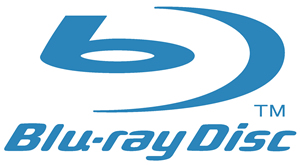BD Vs AOD
2. Page 2
HD-DVD (AOD) Vs Blu-Ray (BD) - Page 1
Sony and Philips, along with Hitachi, LG, Matsushita, Pioneer Samsung Electronics, Sharp and Thomson Multimedia are promoting the "BD" format, which is better known as the "Blu-Ray Disc".
Blu-Ray main specifications
Read-only |
|
Data capacity |
23.3GB/25GB/27GB |
User bit rate |
36Mbps |
Disc diameter |
120mm |
Disc thickness |
1.2mm (optical transmittance protection layer: 0.1mm) |
Recording format |
Phase change recording |
Laser wavelength |
405nm (blue-violet laser) |
Lens numerical aperture (NA) |
0.85 |
Tracking format |
Groove recording |
Tracking pitch |
0.32um |
Addressing Method |
Groove recording |
Shortest pit length |
0.160/0.149/0.138um |
Recording phase density |
16.8/18.0/19.5Gbit/inch |
Video recording format |
MPEG2 video |
Audio recording format |
AC3, MPEG1, Layer2, etc. |
Cartridge dimension |
Approximately 129 x 131 x 7mm |
Video and audio multiplexing format |
MPEG2 transport stream |
Modulation |
1.7PP (Parity preserve/Prohibit RMTR) |
By adopting a 405nm blue-violet semiconductor laser, with a 0.85NA field lens and a 0.1mm optical transmittance protection disc layer structure, it can record up to 27GB video data on a single sided 12cm phase change disc. This means that 2 hours of digital high definition video and more than 13 hours of standard TV broadcasting (VHS/standard definition picture quality, 3.8Mbps) can be recorded on a disc.
In addition, the Blu-Ray specification includes the usage of an optical disc cartridge which protects the optical disc's recording and playback phase from dust and fingerprints.
The basic disadvantage of the Blu-Ray format is that it requires a new manufacturing infrastructure resulting in increased expense while implementation could prove a long-term process. In addition, the Blu-ray Disk format lacks backward compatibility with current DVDs.
Sony, a prime supporter of Blu-ray Disc, has already developed Professional Disc. The format is available in two variants and is targeted at the specific markets of high-definition broadcast quality video and data archiving and storage. The BDZ-S77 is currently available in the Japanese market, but there are not any plans for launching the recorder overseas. Several Japanese companies, including Sony, Hitachi Maxell and TDK, already offer blank Blu-Ray disc media. The recorders and media are expensive, but they are obviously first-generation units whose prices will decline rapidly as market acceptance takes hold.
 In contrast to the HD-DVD proposal, Blu-Ray rejects the use of a new video
compression format, sticking with existing audio/video codecs such as MPEG-2
and Dolby Digital that are specified by the U.S. digital HDTV system. Blu-Ray
media makes use of a completely new technology that requires no new advanced
compression algorithms, and is totally different from either DVD or HD-DVD
(AOD). It will therefore require new facilities for the manufacture of the
discs. Blu-Ray also makes use of a highly specialized high numerical aperture
(0.85) lens and what is called near-field recording technology, using a single
platter 1.1mm thick, with a special 0.1 focusing overlayer on the active side
of the disc. Both HD-DVD and Blu-Ray use 405nm blue-violet lasers for writing
and reading. All DVD-type products require 650nm red lasers and a conventional
focusing system, which are both much cheaper than the 405nm lasers and special
near-field high numerical aperture lens systems required for a Blu-Ray recorder
or player.
In contrast to the HD-DVD proposal, Blu-Ray rejects the use of a new video
compression format, sticking with existing audio/video codecs such as MPEG-2
and Dolby Digital that are specified by the U.S. digital HDTV system. Blu-Ray
media makes use of a completely new technology that requires no new advanced
compression algorithms, and is totally different from either DVD or HD-DVD
(AOD). It will therefore require new facilities for the manufacture of the
discs. Blu-Ray also makes use of a highly specialized high numerical aperture
(0.85) lens and what is called near-field recording technology, using a single
platter 1.1mm thick, with a special 0.1 focusing overlayer on the active side
of the disc. Both HD-DVD and Blu-Ray use 405nm blue-violet lasers for writing
and reading. All DVD-type products require 650nm red lasers and a conventional
focusing system, which are both much cheaper than the 405nm lasers and special
near-field high numerical aperture lens systems required for a Blu-Ray recorder
or player.
The DVD Forum appears to be considering several codecs as candidates for the HD-DVD. These include H.264, the technical specification of which is scheduled to be decided in March; MPEG-4 Advanced Simple Profile; MPEG-2 with a so-called "enhancement layer;" and Microsoft Corp.'s Windows Media 9. All the codecs have reportedly produced satisfactory high-definition quality pictures at the DVD Forum's technical working group, packing 9 Gbytes of high-definition content onto a two-layer DVD using a red laser, with encoding bit rates as low as 7 Mbits/second.
Some days ago, the rewritable HD-DVD (High Definition and High Density-DVD) format was approved in the DVD Forum's general meeting, held in Tokyo. The new format specifies a 12cm optical disc that can store up to 20Gb of data on a single-sided disc. Toshiba and NEC have jointly developed the format, while a read-only version of HD-DVD was approved late last year.













